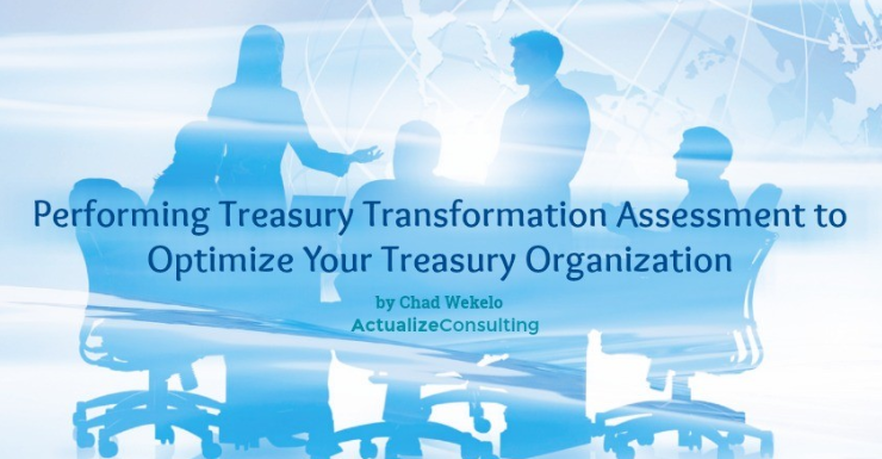|
PERFORMING TREASURY TRANSFORMATION ASSESSMENT TO OPTIMIZE YOUR TREASURY ORGANIZATION TIPS
Chad Wekelo, Principal and Owner at Actualize Consulting. Follow the below steps to perform a Treasury Transformation Assessment in order to optimize your treasury organization: 1.) Define Scope To optimize the treasury initiative, a transformation assessment should be conducted at your organization. The first step in designing this assessment is to define the scope. When developing the scope, all items should be clearly defined and prioritized. Ensure you understand and incorporate the strategic direction of the organization into a plan, obtaining leadership support and commitment from all impacted stakeholders. Create measurable objectives and incorporate them into fabric of the project. 2.) Current State Definition When defining the current state, you should leverage a questionnaire to gather comprehensive and consistent information obtained from a cross section of all groups. Follow up by reviewing the questionnaire responses and tailor interviews based upon the replies. Combining this information with the capability assessment of systems and resources, the current processes can be documented to focus on obtaining data required to drive the key objectives. Finally, actively engage the stakeholders to review and validate these results. 3.) Future State Design Next, the future state should be outlined and designed by first drafting the process flow and creating an ideal future state technology architecture. Include multiple versions to coincide with the roadmap phases. To achieve the desired future state model, the opportunities should be designed to streamline the processes, roles, and responsibilities. Define staffing skill requirements by office and functional area to determine any required realignment of processes or resources to finalize the desired future state. 4.) Prioritized Roadmap A roadmap should then be outlined. A roadmap is a strategic plan describing the steps an organization needs to take to achieve its stated outcomes and goals. It’s important to clearly outline objectives and link tasks and priorities for action in the near, medium, and long term. Create an impact assessment to weigh the benefits versus cost and time required to achieve the desired outcome. Outline the timeline, resources and budget required to achieve the stated objectives and prepare business cases. Metrics and milestones should be defined to allow regular tracking of progress towards the roadmaps' ultimate goals. 5.) Execution and Evaluating Success Finally, ensure firm leadership backs the project and key stakeholders are consistently engaged, participating, and accountable. In the beginning, utilize a phased approach to obtain early wins and minimize project risk. Lastly, incorporate milestones into the project plan to leverage gating criteria including the stakeholder sign-off. If you would like assistance in developing a transformation assessment, you can reach out to me at [email protected].
0 Comments
Your comment will be posted after it is approved.
Leave a Reply. |
News OverviewLatest release news and tips for your Kyriba implementation. Categories
All
Actualize ServicesArchives
December 2020
|
- Home
- News
-
Kyriba ▼
- On-Boarding
- Bank Account Management
- Bank Connectivity
- Bank Fee Analysis
- Bank Statements
- Business Intelligence
- Cash & Forecasting
- Cash Accounting
- Financial Accounting
- Financial Transactions >
- Fraud & Compliance
- GL Reconciliation
- Hedge Accounting
- In-House Banking
- Netting
- Payments
- SSO/SMS
- System Administration
- Valuations
- Mid Market ▼
- Best Practices ▼
-
Actualize Resources ▼
- New Kyriba Consultants
-
Technical Resources ▼
>
- More Education ▼ >
- Bank Account Management
- Bank Fee Analysis
- Bank Connectivity
- Bank Statements
- Kyriba Reporting ▼ >
- Cash & Forecasting
- Cash Accounting
- Core Data
- Connectivity ▼ >
- Data Exchange
- Financial Accounting
- Financial Transactions
- Fraud & Compliance
- GL Reconciliation
- In-house Banking
- Liquidity Planning
- Market Data & MTM
- Netting
- Payments
- Supply Chain Finance
- System Admin & SSO
- Valuations & Risk, Hedge Accounting
- News & General ▼ >
- Project Resources ▼ >
- RPA
- Sales and Account Management
- Training Portal Requests
- Contact


 RSS Feed
RSS Feed